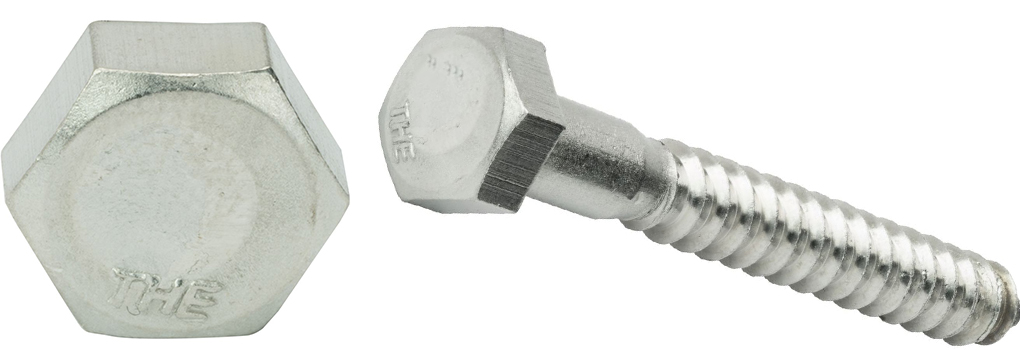What Is A Lag Bolt
What Are Lag Screws Used For?
Lag screws, also called lag bolts, are large wood screws with hexagonal heads. They're used in a variety of applications where it is important to have a screw with lots of holding power. They are typically used to secure lumber and other heavy materials that bear a lot of weight or stress. Their threads create a strong grip on the material, while the head pulls everything together tightly.
Common sizes are 5/16-inch to 3/8-inch, which are massive when compared to other wood fasteners. These extremely sturdy fasteners are usually used to connect heavy lumber or other heavy materials that are bearing an intense load.
Lag screws differ from other types of screws, like drywall screws and deck screws, because they are designed to drive into wood with a wrench or socket. Their heads are usually larger than other screw heads and have a hexagonal shape, so a wrench can turn it. The threads on lag screws are also coarser, which helps them grip the material better than traditional screw threads.
The Origins Of The Lag Screw
The name lag screw comes from their original use in securing barrel staves, also known as lags. A lag screw requires a hole drilled at the same diameter as the shaft of the screw, a gimlet point helps pull the screw into the hole and tap its thread.
What Is the Difference Between a Lag and Metal Screw?
The main difference between a lag screw and a metal screw is their intended use. A screw drives into wood, while a lag screw is designed for use in masonry or other hard surfaces. The threads on a lag screw are also more course than those of a metal screw.
Lag screws most commonly fasten wood and composite materials together. They can also secure metal, stone and concrete. The material you choose will depend on the strength and durability you need.
As far as versatility goes, lag screws are high-quality fasteners for a variety of applications. When used correctly, they provide a strong and secure connection.
How To Use Lag Screws
Simplicity is part of their success; they don't need nuts. They work by burrowing in with coarse threads to create a type of friction joint. The secret to strong, permanent lag bolt joints is the right drill bit for the shank size.
Step 1: Align and Clamp Materials Together
The first thing you’ll need to do is clamp together the two pieces of lumber (or other materials). Measure the width of the two materials together, and pick a lag bolt that’s ¼ inch shorter than the combined width.
Step 2: Drill Pilot Holes through Materials
You’ll need a drill bit that’s slightly smaller than the diameter of your lag screws. This will ensure the lag bolts threads will have enough material to bind to. Drill through both materials at least as deep as the length of your lag bolts. If you want to avoid drilling all the way through, use a piece of tape on your bit to mark the desired hole depth.
Step 3: Drill Countersink Hole
One difference between lag bolts and wood screws is their heads. Lag bolts have large hex heads that protrude out from the material when fastened.
This can be unsightly or even a potential hazard in some situations – think about protruding lag bolt heads on a flat deck. The solution to this is drilling countersink holes to hide the bolt head in the material.
Use a large spade drill bit to create a countersink hole in the pre-drilled pilot holes. Go a little larger than the diameter of the lag bolt head to give enough room for the socket to fasten the bolt flush with the material.
Step 4: Ratchet in Lag Bolts
Use a ratcheting socket wrench to tighten the lag bolts until they’re flush with the material.
You can also use a powered drill to do this if you have the right bit. If you’re going to go this route go slow and steady. Overtightening can cause the bolt to snap off inside the material – leaving you with a serious headache.
Recommended Tools
In general, you will need only a few tools to complete a project with a lag screw. Some of the best options include:
Drill with socket attachment: You’ll need a drill with a socket attachment to tighten the lag bolts. We recommend using a drill because it will make drilling the pilot holes and countersink holes much easier.
Spade drill bit: A spade drill bit creates the countersink holes for the lag bolt heads.
Ratcheting socket wrench: If you don’t have a powered drill, a ratcheting socket wrench will make it easier to tighten the lag bolts.
Lag screws: Of course, you’ll need lag screws! Make sure you get the right size for your project.
Tape measure: This tool will help you make sure you’re using the right-sized lag bolts for your project.
Clamps: Finally, you’ll need clamps to hold the two materials together while you’re drilling the pilot holes.
Lag screws are one of the most versatile and easy-to-use fasteners. With the right tools, you can use them for a variety of projects.


